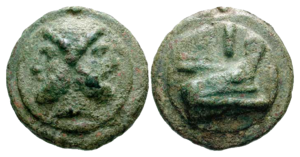Denario
| Denario | |
|---|---|
| Diñeirio Lucreciano (Isurian) Dinaro Lucriciano (Pelaxian | |
| ISO 4217 | |
| Code | LUD |
| Denominations | |
| Superunit | |
| 2 | lauriola |
| 5 | lauro |
| 10 | argento |
| 20 | oro |
| Subunit | |
| 1⁄20 | aramino |
| 1⁄240 | semi |
| Symbol | Ӿ |
| aramino | ֏ |
| semi | ₷ |
| Demographics | |
| Date of introduction | 162 BC 281 AD (1:20:12 currency) |
| User(s) | |
| Issuance | |
| Central bank | National Bank of the Republic |
| Printer | National Bank of the Republic |
| Mint | United Emeritan Mint |
The denario (Isurian: diñeirio; Pelaxian: dinaro; sing: Ӿ; code: LUD) is the currency of Lucrecia and of the preceding Emeritan Republic, the latter having first introduced it in the year 162 BC as a currency of prestige for domestic use only while the previous bronze-based Adonerii currency remained in use for foreign trade and taxation. The name "denario" comes from the Latin term "denarius", which was used as a term to denote a subdivision in several Latinic currencies in Vallos.
The denario is presently subdivided in a ratio of 1:20:12, or one denario for every twenty araminos; one aramino for every twelve semis. A rationalisation of the ancient pre-decimal currencies, it is now seen by some Lucrecians as being antiquated and a vestige of "less enlightened times". Presently, members of the Centuriate and Popular Assemblies have been calling for the decimalisation of the denario to put it in line with other currencies around the world. However, because the Senatorial House is the only legislative house that is allowed to propose bills, these calls have never went beyond proposals.
Etymology
The term denario comes from the Latin word "denarius", which itself comes from the word "'deni'", or "containing ten". Those ten were the old "ases", what used to be the highest denomination of the bronze-based Aes before the silver-based denarius was introduced in 162 BC; there are currently twenty araminos, a word that descends from "aes", in a denario. It is also from the term "denarius" that the Isurian and Pelaxian names for the currency, "diñeirio" and "dinaro", descend from.
The smaller denominations of the denario, the aramino and the semi, are also derived from Latin words, although the true origins of the former are rather unknown. All that is known is that "aramino" derives from "aes", itself originally referring to a bronze plaque that weighed a pound, which was the common benchmark for ancient metal-based currencies. The origins for the term "semi" are much more straight-forward on the other hand, it meaning "half" as a semi coin was once worth half an as, in contrast to a modern semi being worth one-twelfth of an as.
The super-units of the denario all based on Latin terms, "lauriola" (two denarios) is an Emeritan Pelaxian diminutive for "laureate", with "lauro" (five denarios) being a more direct Pelaxian translation. "Argento" (ten denarios) and "oro" (twenty denarios) are respectively from the Latin terms for silver (argenti) and gold (aurum; also the original source of the name of the Aureus, the currency of Caphiria).
History
Adonerii currencies

One of the first currencies to be used by what would become modern-day Lucrecia came from settlers from the Adonerum, most notably the Aes which was a bronze-based coinage currency. Coins of the Aes, which included the now-extant denominations of the Aramino and the Semi, have been found in archaeological digs across the Occident from as north as Urcea to as south as Chrobonsk, which is sometimes argued to be where the southernmost Adonerii settlements are located, though the best-preserved instances have been located in the United Emeritan Mint, which also runs a numismatic museum displaying denominations of coinage dating back to the 8th Century BC.
Introduction of silver currency
Silver coinage had already been introduced to mainland Sarpedon centuries prior to the introduction of the denarius in the nascent Emeritan Republic in the year 162 BC. The Emeritan denarius was initially a form of currency that could only be used in Emerita, it being seen as a currency of prestige, a form of the Aes would remain as the regional currency of the Catenias, and as the currency of taxation and trade on the island of Emerita. This dual currency system in the Emeritan Republic did not last for too long, soon the entirety of the Catenias had made the switch to silver-based currencies, and the denarius stopped being a domestic-only currency for the Emeritans.
Rationalisation
Post-collapse slump
Pelaxian revitalisation
First attempt at banknotes
Second attempt at banknotes
Monetary centralisation
Gold standard
20th Century reforms
Coins
Banknotes
Exchange rates
Decimalisation
The amounts in a denario are currently expressed in denarios, araminos, and semis, with no standard of which notation is considered official. What this means is that a given monetary amount could be written down in several ways: 45֏. 8₷. could mean 45/8, 45-8, Ӿ2. 5֏. 8₷., Ӿ2-5-8, or even Ӿ2/5/8. Since the early 18th Century, there have been proposals from members of the lower legislative houses (everything below the Senatorial House) to decimalise the Denario, with most proposals aiming to have the Denario consist of ten araminos, with each aramino consisting of ten semis. During the limited liberal reforms of the 19th Century and the sweeping reforms of the 1970s, proposals to decimalise the currency were at their most frequent, alongside more radical proposals. Many of these more radical proposals ranged from an attempt in 1852 to replace the Denario with a "regional Taler", based upon the currency of Urcea, to an attempt to adopt an entirely new currency known as the florin. Because the ultimate authority in introducing bills into the General Assemblies is the Senatorial House, all of these proposals did not make it into debate stage.
See also
- [[]]